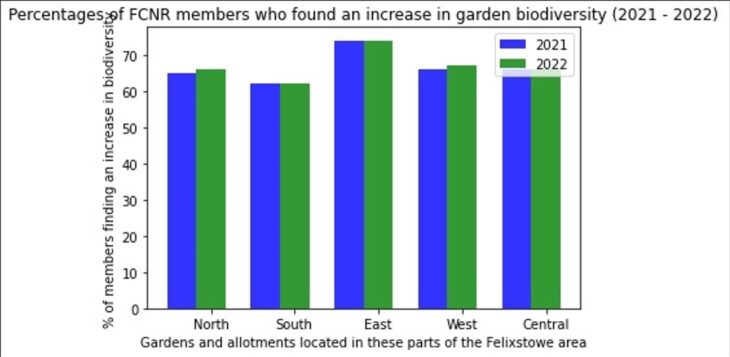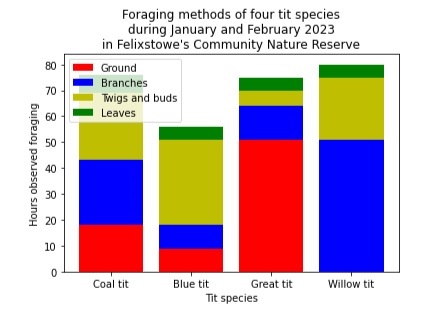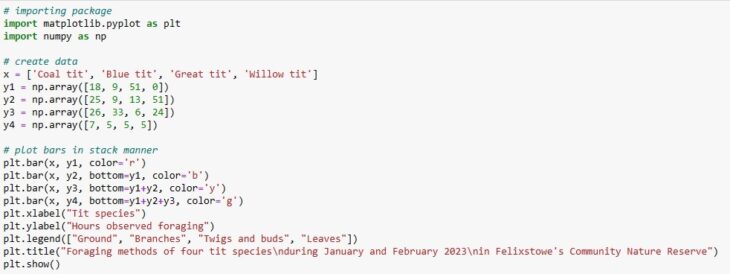Foraging behaviour among four species of tit in Felixstowe’s Community Nature Reserve (January and February 2023)
Written by Dr Adrian Cooper
Introduction and background
This analysis was conducted by the Felixstowe Citizen Science Group (FCSG), located in south east England. They are a team of volunteer citizen scientists whose principal aim is to monitor the impact of Felixstowe’s Community Nature Reserve (FCNR). At the time of writing, FCSG has 36 members. One member has an academic background in Geography. Seven others have studied science to A level standard. The remainder come from an Arts background, or from no academic background. All FCSG members have demonstrated a sustained enthusiasm for citizen science since the group’s founding in April 2018. Further details, and the latest news, of FCSG and FCNR can be found on their Facebook pages.
The main type of impact analysis conducted by FCSG is illustrated by the following case study. It shows the percentages of FCNR members who have found an increase in garden biodiversity as a consequence of their membership, and active participation in the aims of the community nature reserve. The bar charts compare the results from 2022 with the previous year. The chart is further divided between five parts of the Felixstowe area as shown along the horizontal axis. Definitions of ‘biodiversity’ are left for individual respondents to intuitively define for themselves. That is, no simple attempt was made to impose a definition of biodiversity on respondents. The bar charts were created using the Python programming language (Tudor, 2019).

Data on garden ownership for this type of FCSG investigation is drawn from an Excel database which is managed according to GDPR principles.
Team members have been trained in data collection and analysis using Fowler, Cohen and Jarvis (2009).
All FCSG projects focus on at least six aspects of project risk management: (i) organizational risks (ie the stability of FCSG during project development, and organisational support for a project); (ii) user risks (ie FCSG team member involvement during project development); (iii) requirements risks (ie uncertainty surrounding system requirements and frequently changing requirements; (iv) project complexity risks (ie difficulties of the project aims and obligations and its complexity; (v) planning and control risks (ie risks of poor planning, unrealistic schedules and lack of milestones; and (vi) project team risks (ie risks of insufficient knowledge, cooperation, motivation and communication). Management of these project risks is completed through a Responsibility Assignment Matrix.
Investigating foraging behaviour
Before the inception of the tit foraging project, FCSG had not attempted any work on animal behaviour, given its aim to concentrate on impact analyses for FCNR. However, at the end of 2022, the FCSG group decided they wanted to expand their work within the Felixstowe area to include an attempt to engage with an aspect of animal behaviour. Discussion on the practicalities of that ambition led to a focus on ideas of niche (ie those parts of a habitat in which species can exploit opportunities better than their competitors). Since those discussions began in the late autumn and early winter of 2022, the opportunities of analyzing tit foraging behaviour within the gardens and allotments belonging to FCNR members became a realistic option.
As with the impact analysis shown above, the Felixstowe area was divided into five parts: north, south, east, west and central. For each of those areas, a target was set to count tit foraging behaviour in ten gardens and / or allotments, making a total sample size of 50 gardens / allotments. That figure was agreed among FCSG members to be realistic for this first attempt into the investigation of animal behaviour. Inclusion within that sample of 50 was filtered from the FCSG database to only include FCNR members whose gardens and allotments included at least one mature tree. Within that filtered group, the sample took 50 randomly chosen FCNR members.
In each of the 50 gardens / allotments, their owners were given a choice between counting foraging behaviour themselves, or to receive help from an FCSG member. In each case, the garden / allotment owners chose to accept the offer of help and support. To achieve consistency in species identification, each FCSG member was given pictures of the relevant tit species taken from RSPB sources.
The results of this work are shown below:

These stacked bar charts were created using Python. The Python code is included here in the hope that it might encourage other citizen science groups to conduct similar investigations to this one:

Critics of this Python code might suggest that it should have been constructed to receive data from a file located elsewhere. However, in reply, it should be noted that FCSG does not claim to be composed of Python programmers who are trained in the theory of that language. Instead, FCSG has found, from listening to its members, that they prefer to see their data sets integrated into the code so they can see “everything at once” to quote a frequently used expression among FCSG members. Ultimately, whether or not the data comes from a different file, the final data visualisation would be the same as shown above.
The stacked bar graphs clearly show that the four tit species chosen for this work are able to reduce competition for food resources by foraging in different parts of tree vicinities.
This analysis also supports the hypothesis that these four tit species feed in different parts of the tree vicinity in question. Coal tits, for example spent 18 counted hours foraging on the ground during the study period. In contrast, blue tits spent half that number, while great tits spent 51 counted hours foraging on the ground. The willow tits observed in this work spent no time foraging on the ground, preferring to spend 51 counted hours in the branches of their favoured trees. Other contrasts may be drawn from additional aspects of the stacked bar graphs.
Anecdotal observations from the sampling teams suggested that there may have been significant differences in the size of insects eaten by the counted tits – a further indication of niche segregation between the four species considered here.
Conclusions
This project is the first of its kind which has been addressed by FCSG. Initial feedback through social media and informal contact has been encouraging. It is hoped that the project will be attempted again next year to see how foraging patterns have changed. Next year’s version of this project will also incorporate as many learning points as possible which can be drawn from feedback provided by external observers, as well as from internal discussion within FCSG. Further discussion of how FCSG hopes to learn from this project have been examined previously by Cooper (2019).
References
Cooper A (2019) Felixstowe’s Citizen Science Group becomes a learning organization, online available on the NBN Trust website.
Fowler J, Cohen L, and Jarvis P (2009) Practical Statistics for Field Biology, 2nd edition, Chichester, John Wiley.
Tudor J (2019) Python Programming for Beginners (Independently published)
